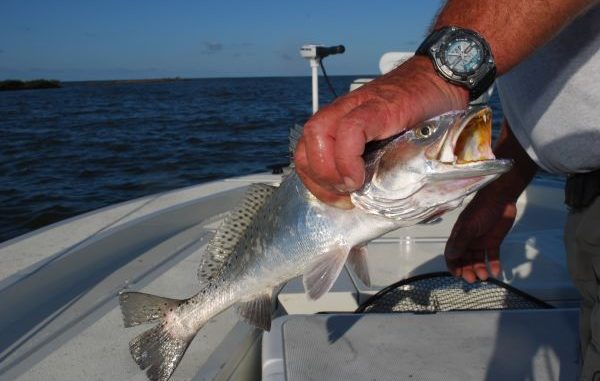
Capt. John Aucoin defines the spring transition period in eastern Terrebonne as the months of March and April. Through February, speckled trout will be found bunched mostly in waters north of Catfish Lake. Clearly not his favorite month to fish, he defines March as a “hit-or-miss” month. Trout are here one day and somewhere else the next.
This month he likes to fish “current lines,” places where two kinds of water meet, whether in main canals or where bayous and main canals empty into small bays — funnel areas in reverse. Water movement is still dominated by cold fronts rather than tide ranges. Fishing is best with at least a foot of tide range.
As conditions change near the end of the month, Aucoin will shift from using 2-inch plastic beetles on 1/8-ounce jig heads and lines of 10- to 12-pound-test to 3-inch beetles on 1/4-ounce jigheads and lines of 15- to 17-pound-test.
In March, speckled trout fishing should be concentrated from the latitude of Catfish Lake down to Lake Raccourci, still in the marsh, but in the lower part of it.
April is a new ball game. Fishermen should begin to look toward open waters like lakes Raccourci and Felicity and Timbalier Bay. From the middle of the month on, it pays to try as far south as the barrier islands, or what used to be islands. It is a fine month to fish, but is still hit-or-miss because of wind.
Using older maps or GPS maps can help locate places where islands used to be in the bays and major lakes. Fish will still hold on these shallows or humps — anything different from the surrounding bottom. Use a depth finder to locate a steep drop off on these hidden features.
Anglers can drift over the spots or anchor. Live cocahoes on the bottom should be the first thing to try. If multiple anglers are in the boat, others should try live cocahoes under corks and plastics on jig heads
If you don’t get a bite, move around the feature, either drifting or trolling if the wind permits. When you find the fish, anchor up and sit on them.
Islands in lakes and bays are very productive. Look for bait — finger mullet schools on the surface, shrimp popping or glass minnows. They will give their presence away by making the water over the school “shake,” a rippling or shivering appearance. If shrimp are there, some birds will often be diving on them.
Stop the big motor about 100 yards from the island and troll-in to look for bait. Fish all around the island. Look for a pattern. Also, look for rips or current lines where two water colors meet or where calm and choppy, wind-driven waters meet.